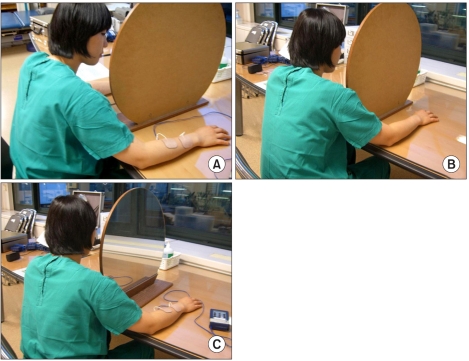Ann Rehabil Med.
2011 Jun;35(3):316-321. 10.5535/arm.2011.35.3.316.
The Synergic Effects of Mirror Therapy and Neuromuscular Electrical Stimulation for Hand Function in Stroke Patients
- Affiliations
-
- 1Department of Rehabilitation Medicine, Asan Medical Center, University of Ulsan College of Medicine, Seoul 138-736, Korea. mhchun@amc.seoul.kr
- 2Department of Rehabilitation Medicine, Phillip Hospital, Seoul 138-170, Korea.
- 3Department of Rehabilitation Medicine, University of Jeju National University Hospital, Jeju 690-756, Korea.
- KMID: 2266849
- DOI: http://doi.org/10.5535/arm.2011.35.3.316
Abstract
OBJECTIVE
To investigate the synergic effects of mirror therapy and neuromuscular electrical stimulation (NMES) for hand function in stroke patients. METHOD: Sixty patients with hemiparesis after stroke were included (41 males and 19 females, average age 63.3 years). Twenty patients had NMES applied and simultaneously underwent mirror therapy. Twenty patients had NMES applied only, and twenty patients underwent mirror therapy only. Each treatment was done five days per week, 30 minutes per day, for three weeks. NMES was applied on the surface of the extensor digitorum communis and extensor pollicis brevis for open-hand motion. Muscle tone, Fugl-Meyer assessment, and power of wrist and hand were evaluated before and after treatment.
RESULTS
There were significant improvements in the Fugl-Meyer assessment score in the wrist, hand and coordination, as well as power of wrist and hand in all groups after treatment. The mirror and NMES group showed significant improvements in the Fugl-Meyer scores of hand, wrist, coordination and power of hand extension compared to the other groups. However, the power of hand flexion, wrist flexion, and wrist extension showed no significant differences among the three groups. Muscle tone also showed no significant differences in the three groups.
CONCLUSION
Our results showed that there is a synergic effect of mirror therapy and NMES on hand function. Therefore, a hand rehabilitation strategy combined with NMES and mirror therapy may be more helpful for improving hand function in stroke patients than NMES or mirror therapy only.
Figure
Cited by 2 articles
-
Efficacy of Mirror Therapy Containing Functional Tasks in Poststroke Patients
Kil-Byung Lim, Hong-Jae Lee, Jeehyun Yoo, Hyun-Ju Yun, Hye-Jung Hwang
Ann Rehabil Med. 2016;40(4):629-636. doi: 10.5535/arm.2016.40.4.629.Neuromuscular Electrical Stimulation and Strength Recovery of Postnatal Diastasis Recti Abdominis Muscles
Dalia M. Kamel, Amel M. Yousif
Ann Rehabil Med. 2017;41(3):465-474. doi: 10.5535/arm.2017.41.3.465.
Reference
-
1. Parker VM, Wade DT, Langton Hewer R. Loss of arm function after stroke: measurement, frequency, and recovery. Int Rehabil Med. 1986; 8:69–73. PMID: 3804600.
Article2. Prange GB, Jannink MJ, Groothuis-Oudshoorn CG, Hermens HJ, Ijzerman MJ. Systematic review of the effect of robot-aided therapy on recovery of the hemiparetic arm after stroke. J Rehabil Res Dev. 2006; 43:171–184. PMID: 16847784.
Article3. Ramachandran VS, Rogers-Ramachandran D. Synaesthesia in phantom limbs induced with mirrors. Proc Biol Sci. 1996; 263:377–386. PMID: 8637922.4. Altschuler EL, Wisdom SB, Stone L, Foster C, Galasko D, Llewellyn DM, Ramachandran VS. Rehabilitation of hemiparesis after stroke with a mirror. Lancet. 1999; 353:2035–2036. PMID: 10376620.
Article5. Stevens JA, Stoykov ME. Using motor imagery in the rehabilitation of hemiparesis. Arch Phys Med Rehabil. 2003; 84:1090–1092. PMID: 12881842.6. Yavuzer G, Selles R, Sezer N, Sutbeyaz S, Bussmann JB, Koseoglu F, Atay MB, Stam HJ. Mirror therapy improves hand function in subacute stroke: a randomized controlled trial. Arch Phys Med Rehabil. 2008; 89:393–398. PMID: 18295613.
Article7. Han TR, Lim SJ, Kim DY, Lee KJ. Stimulation intensity of functional electrical stimulation on hemiplegic upper extremity. J Korean Acad Rehabil Med. 2002; 26:379–384.8. Garry MI, Loftus A, Summers JJ. Mirror, mirror on the wall: viewing a mirror reflection of unilateral hand movements facilitates ipsilateral M1 excitability. Exp Brain Res. 2005; 163:118–122. PMID: 15754176.
Article9. Liepert J, Dettmers C, Terborg C, Weiller C. Inhibition of ipsilateral motor cortex during phasic generation of low force. Clin Neurophysiol. 2001; 112:114–121. PMID: 11137668.
Article10. Kimberley TJ, Lewis SM, Auerbach EJ, Dorsey LL, Lojovich JM, Carey JR. Electrical stimulation driving functional improvements and cortical changes in subjects with stroke. Exp Brain Res. 2004; 154:450–460. PMID: 14618287.
Article11. Wu CW, Seo HJ, Cohen LG. Influence of electric somatosensory stimulation on paretic-hand function in chronic stroke. Arch Phys Med Rehabil. 2006; 87:351–357. PMID: 16500168.
Article12. Wu CW, van Gelderen P, Hanakawa T, Yaseen Z, Cohen LG. Enduring representational plasticity after somatosensory stimulation. Neuroimage. 2005; 27:872–884. PMID: 16084740.
Article13. Conforto AB, Kaelin-Lang A, Cohen LG. Increase in hand muscle strength of stroke patients after somatosensory stimulation. Ann Neurol. 2002; 51:122–125. PMID: 11782992.
Article14. de Kroon JR, van der Lee JH, IJzerman MJ, Lankhorst GJ. Therapeutic electrical stimulation to improve motor control and functional abilities of the upper extremity after stroke: a systematic review. Clin Rehabil. 2002; 16:350–360. PMID: 12061468.
Article15. Cauraugh J, Light K, Kim S, Thigpen M, Behrman A. Chronic motor dysfunction after stroke: recovering wrist and finger extension by electromyography-triggered neuromuscular stimulation. Stroke. 2000; 31:1360–1364. PMID: 10835457.16. Santos M, Zahner LH, McKiernan BJ, Mahnken JD, Quaney B. Neuromuscular electrical stimulation improves severe hand dysfunction for individuals with chronic stroke: a pilot study. J Neurol Phys Ther. 2006; 30:175–183. PMID: 17233925.
- Full Text Links
- Actions
-
Cited
- CITED
-
- Close
- Share
- Similar articles
-
- Neuromuscular Electrical Stimulation for Dysphagia
- Effects of Neuromuscular Electrical Stimulation in Combination with Saliva or Dry Swallowing in Stroke Patients with Dysphagia
- The Effect of an Abdominal Drawing-In Maneuver Combined with Low·High Frequency Neuromuscular Electrical Stimulation on Trunk Muscle Activity, Muscle Fatigue, and Balance in Stroke Patients
- Facilitation of Corticospinal Excitability According to Motor Imagery and Mirror Therapy in Healthy Subjects and Stroke Patients
- Rewiring the Lesioned Brain: Electrical Stimulation for Post-Stroke Motor Restoration


